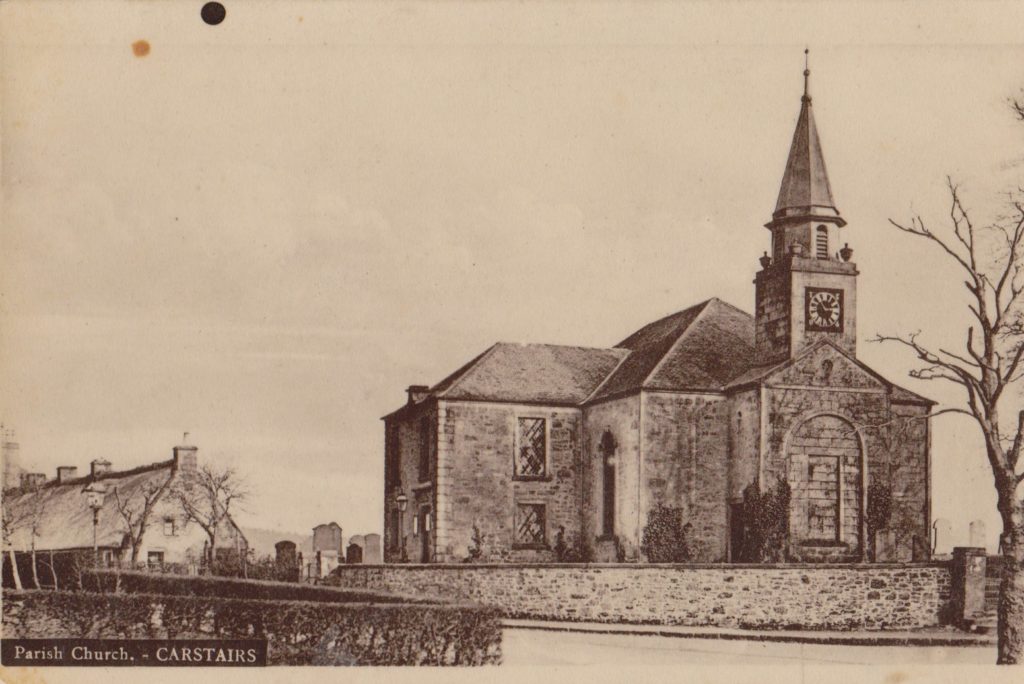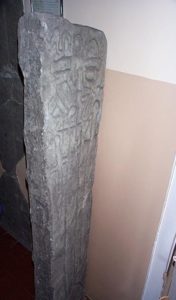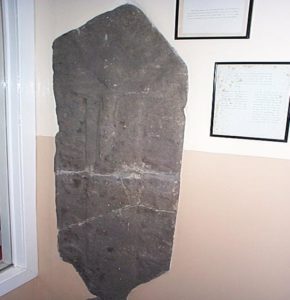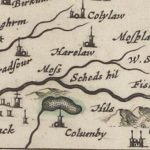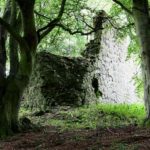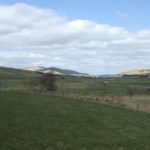The book, McCallum’s Clydesdale, was written in 1924. It is a mine of useful information and a special chapter is devoted to Carstairs. In his book McCallum describes how he found several gravestones in the vestry which had been found by the grave diggers. One of these has on it a crucifixion scene. The Reformers destroyed virtually every item displaying the crucified Christ as they considered that a Papist abomination. However, the vestry area is impressive, being converted into a little museum. On display was a Mediaeval Skillet. It was labelled a Roman Camp Kettle.

What of the skillet? It is typical of the 14th century and was found in the late 19th century at Columbie farm. Unfortunately, it is slightly damaged as somebody put their pickaxe through it when it was discovered.
It is not the only Mediaeval discovery made near the site of the Bishop’s castle. In 1812 a drainage scheme was being undertaken nearby and a cow’s hoof was apparently found with a group of Edwardian pennies in it. The location of this small coin hoard is presently unknown.
Who used this skillet? We will never know whether it belonged to one of Edward I’s soldiers or to the Scottish garrison. In Edward I’s time, the castle was known as Chastel Terres—a name derived from the old Motte and Bailey Castle. Translated into English from Anglo Norman French this name that later became Carstairs means—Earth Castle. Wallace’s friend Bishop Wishart got permission from Edward I to make a stone castle. However, Edward was soon to learn that Bishop Wishart was no friend and indeed he helped both Wallace and Bruce. After the battle of Falkirk in 1298 Edward I quickly regained control of the castles in Lanarkshire as we have records that give us this information.
The calendar of documents relating to Scotland tell us that on September 21, 1301 that Alexander de Balliol of Cavers was awaiting orders from Sir Walter de Borudoun (Burdon) who was based at Carstairs. Walter Burdon held an important job in that he was then not only in charge of Carstairs but he was then the Sheriff of Peebles. It would have been his job to keep an eye on William Wallace.
Further references are made to the castle at Carstairs in the Exchequer rolls for November to December 1302. At that time the garrison included Walter Burdon, 10 men at arms, 20 named soldiers including Peter of Liberton (whether this was Liberton near Edinburgh or a local recruit from Liberton near Carnwath, we will never know) and finally forty footmen. This is quite an impressive garrison amounting to seventy men, Lanark Castle never had nearly as many men. Indeed, it only had a garrison of fifteen. However, for its time Carstairs was definitely state of the art, but it does not figure as a major castle after the period of the Wars of Independence. Its strategic position was lost and the castle gradually drifted into obscurity though there is a reference to it in the time James, 2nd Earl of Arran and one time Regent of Scotland. That was in 1542 after James V died after the battle of Solway Moss. There may also be an illustration of it on Pont’s map of Lanarkshire in 1570.
There is reference to the garrison in 1306 when Richard of Bromsgrove who was responsible for ensuring the safe transit of supplies from Leith to Carstairs for the maintenance of the garrison. We also hear that Edward II came here from Biggar on October 8th, 1310 before going on to Cambusnethan the following day. Somebody in this period that I have been describing would have used the skillet.
It could be that the picture showing the cross and sword was made in the fourteenth century. It is certainly typical of that time, but it must have been exposed to the elements for a long time as it is very worn. The interesting thing about it is that it has been reused in the late Middle Ages. The decoration is quite unlike anything I have ever seen before and is a local craftsman’s interpretation of the designs on the backside. Quite when it was made is difficult to say but it was not exposed to the weather too long before it was buried.
The slab with the crucifixion scene on the first page is 15th century in date and quite what its purpose is difficult to say. It is very unusual to have crucifixion scenes on grave stones but I have seen several examples as Monumental Brasses and these date back to the 14th century. However going by the style of lettering—a date of the fifteenth century would seem to be more appropriate. My conclusion is that it is the grave slab of a local cleric and may have been made locally. Like the slab above the quality of workmanship is not there and I would be surprised if it was somebody notable as there were craftsmen capable of producing really good quality workmanship at that period within Scotland.
There are other features worth examining at Carstairs and I think a good look at the sculptured stones in the churchyard would not come amiss as I feel that next to no work has been done on them as yet and I think they are the key to much of what needs to be found out. The place where an investigation would be useful would be the Blackadder aisle in Glasgow Cathedral. Archbishop Blackadder was a great patron of Glasgow Cathedral as well as being a great patron of Carstairs and a comparison of the sculpture from both places would be useful.

The next item for consideration is a corbel head. What was a corbel head? A corbel head was a stone support for a roof beam and it jutted out from the side wall of the church. The standard of workmanship is very high and I would think that it falls into the 14/15th century era. It is not quite so crude and heavy as much of the work of the period of Archbishop Blackadder. Could this head be of St Mary after whom the church was called?
What about the early church—any remains? Yes—these were discovered in the 19th century and were misinterpreted as a Roman Bath. This is not difficult as the apse of a 12th century church would look very much like a Roman bathhouse and of course there were Roman remains nearby which people had been aware of for many centuries. In fact, not long before the apse was found in the churchyard, there was a hoard of Bronze Sestertii of the Emperor Hadrian found in the grounds of Monteith House near the old Fullerton Mill. This is an unusual find as hoards normally contain silver and this fact was commented on by George Macdonald in an article on coin hoards in the Proceedings of the Society of Antiquaries for 1918. The story of the bathhouse emerged in Stuart’s Caledonia Romana in 1856 and was repeated thereafter. However, apart from the Sestertii, there are reasons for suggesting a camp at Carstairs and that is the proximity of Carstairs to the fort at Castledykes. Good idea, but the main problem is that anything in the village is a long way from the Roman road which runs about a mile to the south through the grounds of Monteith House.
There is in fact a marching camp located approximately 200 meters to the east and south of Monteith House on the flat land adjacent to the Clyde. This was the type of land that the Romans loved for their camps whereas the land in Carstairs village would hold little appeal for the Roman military.
It would be great if I was proved wrong, but I would really like to find out about the church of St Mary Wellbent of the Bishops / Archbishops. Watch this space for further updates.
Unless otherwise stated, all text, images, and other media content are protected under copyright. If you wish to share any content featured on Clydesdale's Heritage, please get in touch to request permission.
